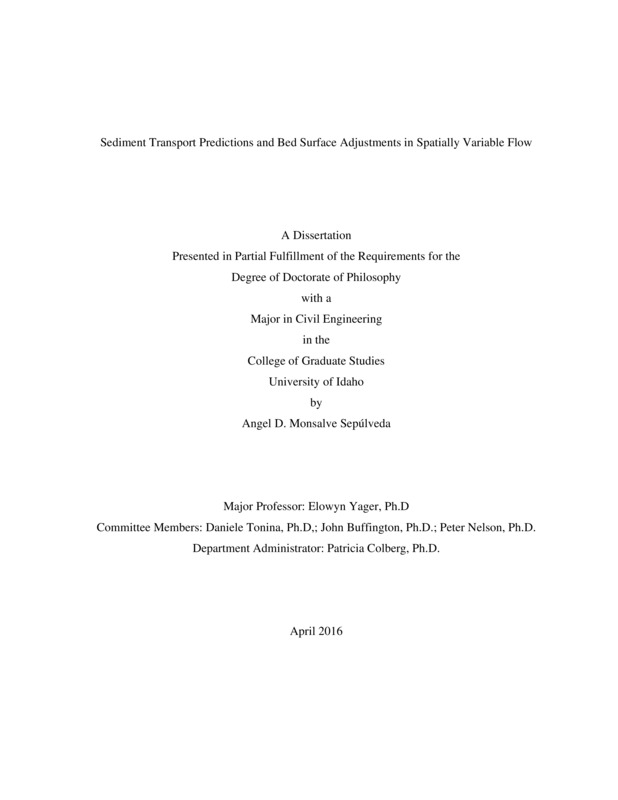Sediment Transport Predictions and Bed Surface Adjustments in Spatially Variable Flow
Monsalve, Angel Dario. (2016). Sediment Transport Predictions and Bed Surface Adjustments in Spatially Variable Flow. Theses and Dissertations Collection, University of Idaho Library Digital Collections. https://www.lib.uidaho.edu/digital/etd/items/monsalve_idaho_0089e_10813.html
- Title:
- Sediment Transport Predictions and Bed Surface Adjustments in Spatially Variable Flow
- Author:
- Monsalve, Angel Dario
- Date:
- 2016
- Keywords:
- High gradient channel Numerical modelling Sediment patches Sediment transport
- Program:
- Civil Engineering
- Subject Category:
- Civil engineering; Geomorphology
- Abstract:
-
In mountainous rivers bedforms, large relatively immobile grains, and bed texture and topographic variability, and can significantly alter local and reach-averaged flow characteristics but this variability is often omitted in bed load calculations. To explore the influence of spatially variable flow in sediment transport fluxes and bed adjustments I conducted a field study to developed and test a probabilistic bed load transport equation that explicitly includes local variations in the flow field and grain size distribution and a set of flume experiments in which I varied the relative submergence while holding the average sediment transport capacity and upstream sediment supply constant. Spatially variable flow parameters were calculated using a quasi-3D and 3D RANS-VOF model for the field and flume studies, respectively. The boundary shear stress field in the field study displayed substantial variability between sediment patch classes, but the patch mean dimensionless shear stress varied inversely with patch median grain size. I developed an empirical relation between the applied shear stress on each patch class and the reach averaged shear stress and median grain size which when used in my bed load equation was more accurate than current bed load transport equations. For the laboratory experiment commonly used theoretical velocity profiles only performed correctly at the reach scale when the roughness length of the relatively mobile sediment was considered, at the local scale large deviations from these profiles were observed. When bedforms were created they altered the spatial distribution of boundary shear stresses and caused significant deviations from hydrostatic pressure. Zones of high turbulent kinetic energy occurred near the water surface and were largely controlled by the immobile grains and plunging flow. Our results suggest that when spatially variable grain size distributions (e.g. patches of sediment) are present they must be explicitly included in bed load transport calculations. Simple methods to estimate boundary shear stresses based on velocity profiles may not perform correctly at the local scale and the effect of bedforms must be explicitly consider for accurate flow predictions.
- Description:
- doctoral, Ph.D., Civil Engineering -- University of Idaho - College of Graduate Studies, 2016
- Major Professor:
- Yager, Elowyn M
- Committee:
- Tonina, Daniele; Buffington, John; Nelson, Peter
- Defense Date:
- 2016
- Identifier:
- Monsalve_idaho_0089E_10813
- Type:
- Text
- Format Original:
- Format:
- application/pdf
- Rights:
- In Copyright - Educational Use Permitted. For more information, please contact University of Idaho Library Special Collections and Archives Department at libspec@uidaho.edu.
- Standardized Rights:
- http://rightsstatements.org/vocab/InC-EDU/1.0/

